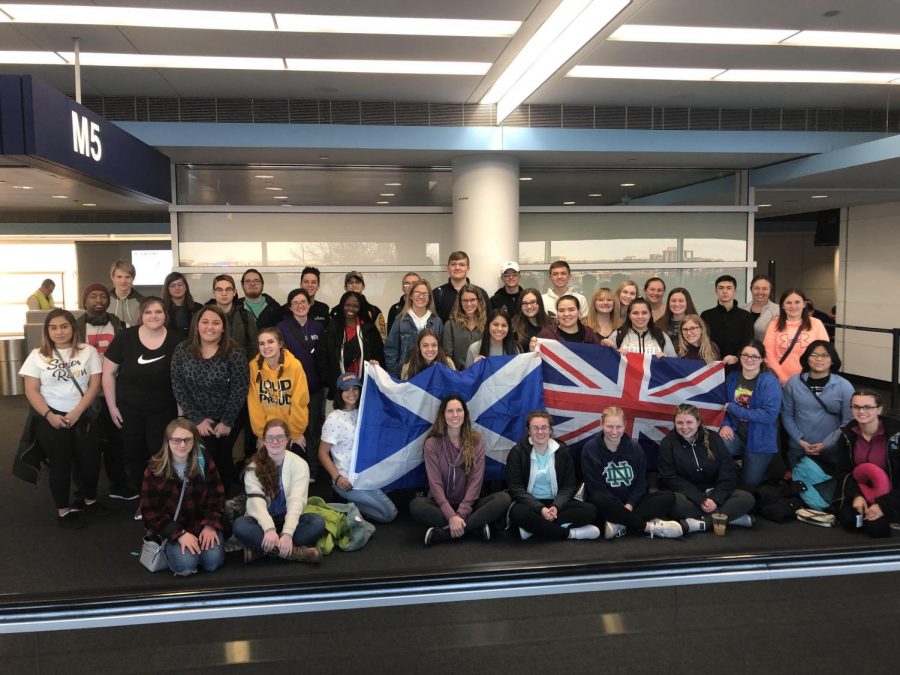GHS Travel Visits Scotland, England
April 23, 2019
From March 25 to April 2, fifty students, parents, and teachers, led by teachers Kristina Collard, Julie Wencloff, Jenna Berzy, and Carl Dunlap, explored Scotland and England on an Education First (EF) Tour over spring break to learn about the history and culture of the United Kingdom. Students were handpicked by Collard and Wencloff in 2017. Costs for the trip amounted to over two thousand dollars; parents had to make monthly payments to EF, and the Travel Group hosted various fundraisers. However, the students, teachers, and a few accompanying parents experienced the journey of lifetime, seeing world-famous landmarks and learning the meanings behind them. The students were gone for nine days and returned to school immediately after their return.
“It was open enrollment,” said Wencloff. “We sent letters out to seniors, juniors, and sophomores who were in good academic standing. But anyone could join.”
A few parents came along to chaperone, most notably Paul Thomas and Kathryn Thomas, parents of junior Sarah Thomas. P. Thomas grew up in London, and K. Thomas lived in London for a year. The forty students were split into five pods of eight to ten kids, led by one or two adults, to make it easier to keep track of everyone. Students chose who they wanted to share a hotel room and possibly a bed with ahead of time.
Fundraising for the trip began in fall 2017, with the travel group selling cards from Baker’s Square that could be exchanged for a pie. They also sold Christmas wreaths, mattresses, and Earth Day t-shirts. On March 24, 2018, they hosted a Bunny Breakfast with an egg hunt, breakfast, and a cake walk.
Monthly meetings were held in the LGI to prepare parents and students for the trip. At first, the meetings were mostly about fundraising, but as the voyage drew closer, the focus shifted. Parents learned what supplies would be needed, such as converters for European outlets. Students were taught about airport security and etiquette for travelers. Teachers warned them they would be on a tight schedule and would need to be quick, responsible, and respectful. They would be allowed a suitcase and two carry-ons on the airplane, but suitcases could not weigh more than fifty pounds; everyone had to pack lightly. The teachers gave a brief overview of English culture, from cuisine to historic landmarks they would be visiting. As the departure date drew closer, the anticipation steepened.
Families began packing the week or weekend before Spring Break, when the trip would take place. Comfortable, durable clothes and walking shoes were a must. A raincoat and sweaters would combat the cold early spring of Scotland and England. Every student had to check to make sure they had their passport. On March 24, the day before the departure, suitcases were dropped off at school to be weighed, checked, and tied with a blue ribbon so they would know it belonged to a Griffith traveler.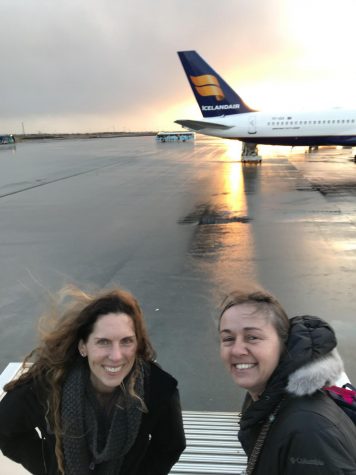
On March 25, at 1:00 p.m., parents drove their children with their carry-ons to school to board a school bus that would take them to O’Hare International Airport in Chicago. The kids grabbed their suitcases and said goodbye to their families. For children and parents alike, parting for such a long time was difficult. Two buses- one for people, the other for suitcases- drove them to O’Hare, where they passed through luggage and security and acquired their boarding passes. The group spent a few hours waiting to board; everyone took
the opportunity to fill up water bottles and purchase dinner. Finally, at 7:00 p.m., the group boarded the plane. At 7:30 p.m., the plane to Reykjavik, the capital of Iceland, took off. It flew overnight and landed in Reykjavik at dawn; from there the group disembarked and boarded a second plane for a two hour flight to Glasgow, Scotland.
When they arrived in Scotland, the
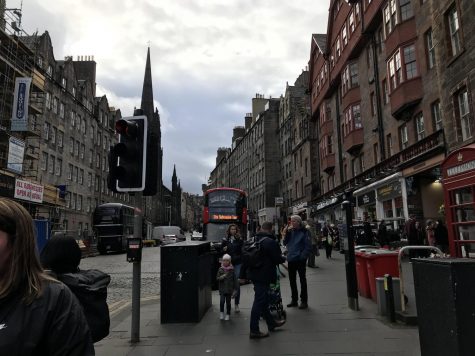
GHS Travel Group was exhausted, jetlagged, and hungry. They bought small meals at the airport after getting their luggage and waited for their tour guide, Joe Mernagh.
“He was really nice and cared about us having a good time,” said Jenna Berzy, a teacher. Mernagh had an extensive knowledge of the history of Scotland and England and gave the students lectures as they saw a myriad of monuments and historic sites. He helped the teachers keep track of the kids and guided them through the city streets, offering new tidbits of information along the way.
After eating, the group got on their coach, driven by Paula, to drive to Edinburgh, the capital of Scotland and home to centuries of history. The city was a sight to behold, with steepled cathedrals, winding cobblestone streets, and antiquated stone buildings that made for a low but beautiful skyline. Over the city towered Edinburgh Castle, which was built atop an extinct
volcano known as Castle Rock. Sometimes they would spot musicians dressed in traditional tartans and kilts played bagpipes on the streets; gift shops hawked magnets, key chains, and wool tartan scarves. The streets were bustling with cars, but that didn’t stop pedestrians from dashing across at the first chance they got, regardless of the traffic signals. For the Americans, the streets were baffling since cars drive on the left side of the road in Britain.
Mernagh led the troupe through the streets of Edinburgh. Their first stop was the National Museum of Scotland, where students got an hour to explore in 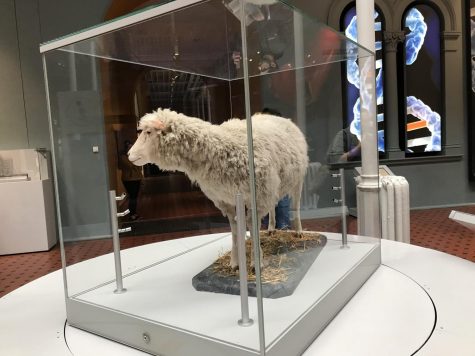 groups of
groups of 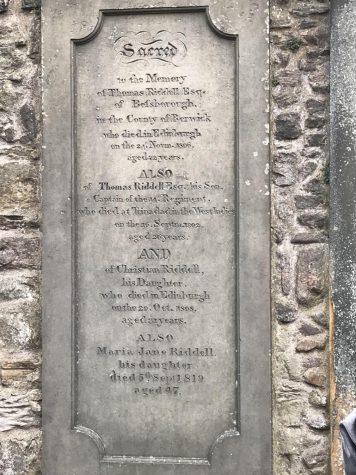 two or more. Exhibits included James Watts’s steam engine that started the Industrial Revolution, a history of Scotland, and Dolly the Sheep, the first cloned animal in the world.
two or more. Exhibits included James Watts’s steam engine that started the Industrial Revolution, a history of Scotland, and Dolly the Sheep, the first cloned animal in the world.
Next was Greyfriars Kirkyard, a church and graveyard in use since the 16th century. Notable burials there include: William McGonagall, poet and inspiration for the name of Harry Potter’s Professor McGonagall; “Bloody” George MacKenzie, who murdered hundreds of Prestybrian prisoners held near the Kirkyard during the 1600s through maltreatment; Greyfriars Bobby, a terrier who spent fourteen years guarding the grave of his master until his own death; and Thomas Riddell, the inspiration for the iconic villain Voldemort of Harry Potter. GHS has a huge Harry Potter fanbase, so the teenagers had a field day searching for Tom Riddell’s grave and marveled at the fact that they were walking in the same place that Rowling found inspiration for her beloved characters’ names.
Mernagh then led the group to the Scott Monument, a two hundred foot tower celebrating the life of Sir Walter Scott, beloved poet, novelist, and historian who found Scotland’s hidden crown jewels. The Scott Monument overlooked a large park in which the National Gallery sat; students were allowed to roam the vicinity in groups of two or more and had to meet back at the Monument at 3:00 p.m..
“It was small enough town to see most of the city, and Edinburgh Castle sitting on top to look down at the city was picturesque,” said Wencloff. “It was historical. Gothic. I would like to go back.”
Finally, the group walked to The Rosehip for a dinner of bangers and mash (sausages and mashed potatoes) complemented by a dessert of raspberry cranachan, a traditional Scottish dish consisting of whipped cream mixed with raspberries to honor the harvest. Everyone got the same meal for every supper. The coach returned and drove them to The Beveridge Park Hotel in Kirkcaldy, Scotland.
Students woke up bright and early the following morning for another tour of Edinburgh. Breakfast at every hotel lasted from 7:30 to 8:30. Teachers and tour guides wanted to depart by 8:30 at the latest. Scottish and English breakfast choices included plenty of breads (buns, muffins, croissants), meats (sausages and ham), and baked beans. Some students woke up early to talk a walk to the North Sea.
The third day of the voyage started off with a bus tour of Edinburgh, narrated by a tour guide named Hannah. The coach passed the childhood home of author Robert Louis Stevenson and the park where he played as a child. The group learned about the history of the architecture, from the medieval buildings to the Georgian townhomes converted into shops and the people who lived in them. The coach passed the Palace of Holyrood, the official Scottish residence of Queen Elizabeth II, meandered through the adjacent park, and stopped for a few pictures at Arthur’s Seat, an ancient volcano and the park’s highest point. They then passed the University of Edinburgh, which was founded in 1582, and finally reached their ultimate destination: Edinburgh Castle.
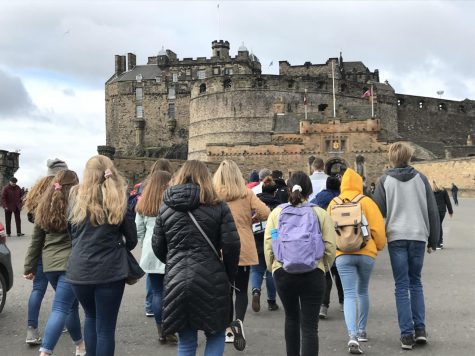 Edinburgh Castle is the city’s oldest building. It is home to Scotland’s crown jewels, known as the Honours, and the birthplace of King James I, successor to Elizabeth I of England and first king of Great Britain (Scotland and England united). Once they passed through the arched stone gates, the group was able to explore the complex, which included the Great Hall, St. Margaret’s Chapel (the oldest building in the castle, from the 12th century), soldiers’ barracks, a prison, and the National War Museum of Scotland. Everyone gathered in Crown Square, the castle’s main plaza, for the One O’Clock Gun; a cannon is fired every day at one o’clock except for Sundays, Good Friday, and Christmas Day.
Edinburgh Castle is the city’s oldest building. It is home to Scotland’s crown jewels, known as the Honours, and the birthplace of King James I, successor to Elizabeth I of England and first king of Great Britain (Scotland and England united). Once they passed through the arched stone gates, the group was able to explore the complex, which included the Great Hall, St. Margaret’s Chapel (the oldest building in the castle, from the 12th century), soldiers’ barracks, a prison, and the National War Museum of Scotland. Everyone gathered in Crown Square, the castle’s main plaza, for the One O’Clock Gun; a cannon is fired every day at one o’clock except for Sundays, Good Friday, and Christmas Day.
After the castle, students were able to wander the city to go shopping or sightseeing in groups of three or more. Dinner was at a pizzeria, consisting of pizza and pasta with a dessert of ice cream. The group trudged back to an old church where two guides awaited to give them a nightly ghost tour of Scotland’s most haunted city. The GHS group diverged into two halves, one for each guide. The guides led them all over the city, into dark alleys where murders occurred, lots beneath apartment buildings erected on cursed land, back to the Kirkyard to visit Bloody Mackenzie’s tomb, and through the real Diagon Alley that inspired Rowling. At each site, the guides had new terrifying tales of torture, execution, and ghosts all based on real people.
The morning after the ghost tour, the travel group packed up everything and said goodbye to Edinburgh. The coach drove them through the countryside of Scotland, which consisted of rolling green fields with grazing sheep. They made a stop at Gretna Green, a village famous for its lax marriage laws. Back in the day, young couples eloped there since one could be married at twelve if female, fourteen if male, without parental consent. The company ate lunch there and bought souvenirs. After that, they were back on the road.
 A few hours later, the coach reached the town of York, where they visited York Minster, a splendid cathedral vital to England’s history. One of the largest churches in Europe, it dates back to Roman times, when it was an army fortress, and has since been built upon with centuries of Norman and Gothic architecture, stain glass windows, and beautifully carved tombs for significant people. Afterwards, the group left York and moved into their new hotel, where they enjoyed a dinner of cottage pie, or Shepherd’s pie in America.
A few hours later, the coach reached the town of York, where they visited York Minster, a splendid cathedral vital to England’s history. One of the largest churches in Europe, it dates back to Roman times, when it was an army fortress, and has since been built upon with centuries of Norman and Gothic architecture, stain glass windows, and beautifully carved tombs for significant people. Afterwards, the group left York and moved into their new hotel, where they enjoyed a dinner of cottage pie, or Shepherd’s pie in America.
The next day, the travelers journeyed to Warwick Castle, built by William the 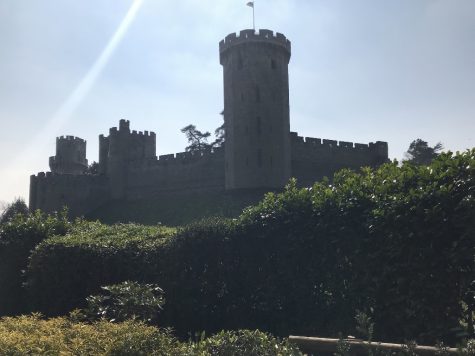 Conqueror in 1068. The stuff of medieval legend, the castle rests on the banks of the Avon River and has a dry moat filled with daffodils. The castle included countless exhibits, more than any one group could do in a few hours. There were displays with wax figures of previous inhabitants, like the Kingmaker Richard Neville, Earl of Warwick, and Daisy Greville, the scandalous Victorian Countess of Warwick. Classical paintings of monarchs, suits of armor, elaborate chapels and drawing rooms, tours of grim dungeons, and even workshops for archery and swordplay were all available. After eating lunch and assaulting the gift shop as usual, they were off again. Dunlap and P. Thomas engaged in a wooden sword fight that was caught on camera and put on Facebook.
Conqueror in 1068. The stuff of medieval legend, the castle rests on the banks of the Avon River and has a dry moat filled with daffodils. The castle included countless exhibits, more than any one group could do in a few hours. There were displays with wax figures of previous inhabitants, like the Kingmaker Richard Neville, Earl of Warwick, and Daisy Greville, the scandalous Victorian Countess of Warwick. Classical paintings of monarchs, suits of armor, elaborate chapels and drawing rooms, tours of grim dungeons, and even workshops for archery and swordplay were all available. After eating lunch and assaulting the gift shop as usual, they were off again. Dunlap and P. Thomas engaged in a wooden sword fight that was caught on camera and put on Facebook.
“Warwick Castle was Number One on my list,” said Wencloff. “The lifelike exhibits made you feel like you were there, in their time. There was the Birds of Prey Show, a show with falcons, owls, and vultures. Birds flew over people from one perching point to another. They talked about the history of birds at the castle and played music. It was my favorite part of the trip.”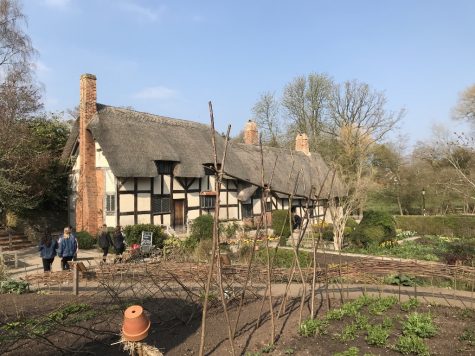
The excitement of the castle was followed by a visit to Anne Hathaway’s childhood home. Hathaway was the wife of famous playwright William Shakespeare; it was here that thirteen generations of her family lived. Students got to see what her house looked like when she grew up and throughout later generations. They stepped on the same floor that Shakespeare and Hathaway trod. Hathaway’s cottage was complemented by a large, blooming garden dedicated to her love with the Bard. Seeing that time was short, Mernagh hurried everyone to their next destination: Shakespeare’s birthplace.
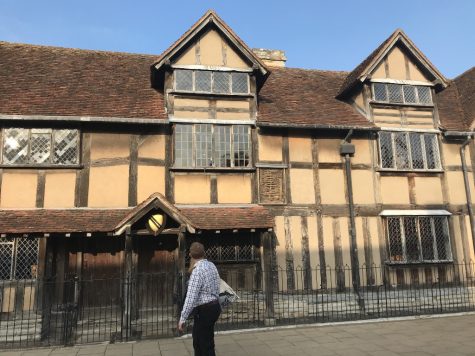 Shakespeare was born in his parents’ home in 1564, in a half-timbered house converted to an inn in later centuries. The group got to walk through the rooms of the house, the home where the Bard was born and grew up with. The rooms’ surviving furniture is preserved and arranged to look as it may have back when the poet lived. Plaques placed throughout the house describe Shakespeare’s impact on the world of literature, media, and English. The birthing room, including the bed Shakespeare’s mother gave birth in, was located on the second story, cut off from the walking area and kept in pristine condition. Below, in the courtyard and gardens, Collard and several students were invited to act out the tragic story of Thisbe and Pyramus from Shakespeare’s A Midsummer Night’s Dream, directed by an eager actor/docent.
Shakespeare was born in his parents’ home in 1564, in a half-timbered house converted to an inn in later centuries. The group got to walk through the rooms of the house, the home where the Bard was born and grew up with. The rooms’ surviving furniture is preserved and arranged to look as it may have back when the poet lived. Plaques placed throughout the house describe Shakespeare’s impact on the world of literature, media, and English. The birthing room, including the bed Shakespeare’s mother gave birth in, was located on the second story, cut off from the walking area and kept in pristine condition. Below, in the courtyard and gardens, Collard and several students were invited to act out the tragic story of Thisbe and Pyramus from Shakespeare’s A Midsummer Night’s Dream, directed by an eager actor/docent.
After sacking another gift shop, the students wandered the cobblestone streets of Stratford-upon-Avon, visiting tourist shops and listening to live violin music performed by a soloist down the street. Purchases were quite heterogeneous, ranging from Harry Potter merchandise purchased at nearby store Alohomora to three miniature guitars from a gift shop to an English teapot. The group then rode the coach to a Holiday Inn in Birmingham, England, for a one night stay.
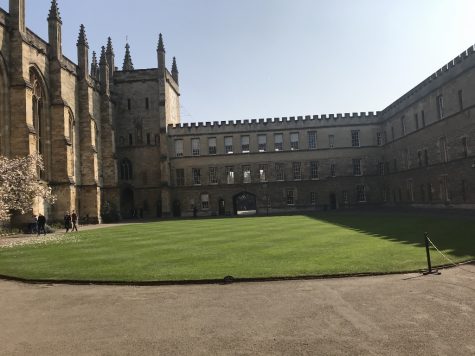 The sixth day of traveling started with a visit to the city of Oxford, where the first university in the English speaking world, Oxford, was built. The University of Oxford includes thirty-eight colleges and is layered with centuries of medieval and modern English history. The students visited New College, established in 1379, where they could tour the chapel, the gardens, and the famous Quadrangle courtyard. They also were able to split into smaller pods to explore town. Beloved authors C. S. Lewis and J. R. R. Tolkien, along with a myriad of famous artists, politicians, and historical figures, attended Oxford and walked the same ancient roads. Just like the university, Oxford the town was full of famous sites, like the Sheldonian Theatre, the expansive bookstore Blackwell’s, the Ashmolean Museum of Art and Archaeology, and the Martyrs’ Memorial, a testament to Thomas Cranmer and two other Anglican bishops burned alive on the orders of Queen Mary I (Bloody Mary). The group reconvened at the Martyrs’ Memorial and got back on the bus for one last ride with Paula to London.
The sixth day of traveling started with a visit to the city of Oxford, where the first university in the English speaking world, Oxford, was built. The University of Oxford includes thirty-eight colleges and is layered with centuries of medieval and modern English history. The students visited New College, established in 1379, where they could tour the chapel, the gardens, and the famous Quadrangle courtyard. They also were able to split into smaller pods to explore town. Beloved authors C. S. Lewis and J. R. R. Tolkien, along with a myriad of famous artists, politicians, and historical figures, attended Oxford and walked the same ancient roads. Just like the university, Oxford the town was full of famous sites, like the Sheldonian Theatre, the expansive bookstore Blackwell’s, the Ashmolean Museum of Art and Archaeology, and the Martyrs’ Memorial, a testament to Thomas Cranmer and two other Anglican bishops burned alive on the orders of Queen Mary I (Bloody Mary). The group reconvened at the Martyrs’ Memorial and got back on the bus for one last ride with Paula to London.
The Atrium Hotel, their final lodging, was not finished with construction or even scheduled to open until early April. The GHS group was essentially the guinea pigs to see how the staff would handle guests. The Atrium surprised the students with its looped shape, blue siding, and modern architecture. The GHS travelers were the only guests in the unfinished hotel, but service was excellent. Students who’d been sharing beds in other hotels were happy to find everyone had their own twin bed. The Atrium was located right next to Heathrow Airport and just across the street from the Hatton Cross subway station, which connected straight to the London Underground.
After settling in, the pods and their respective leaders bravely took on the London Underground, a public rapid transit system of trains and subways in a city of eight million people. The Thomases got to show off their expertise, herding their pod on and off the trains and different lines. “I was really glad that they came,” said junior Sarah Thomas. “It was nice to see it [England] again with them since it’s been a long time. We could go off the beaten road for lunch to restaurants we’d been to or haven’t tried. My parents like to be involved and were very happy to share in this experience. They loved helping everyone on and off the tube and being able to show off the city [of London]. It brought back some very good memories.”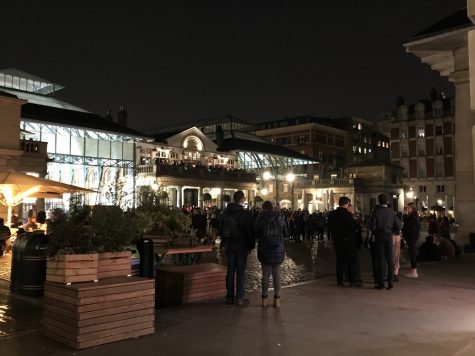
Dinner was at Bibimbap [Bee – bim – bop], a Korean restaurant on Charlotte Street, where the group ate bibimbap- a rice dish consisting of rice mixed with meat and various vegetables. Students could eat with either chopsticks or a spoon. The Thomas family celebrated Sarah Thomas’s seventeenth birthday, presenting her with a Shaun the Sheep-themed cake. For dessert, the pods took the tube to Leicester Square, teaming 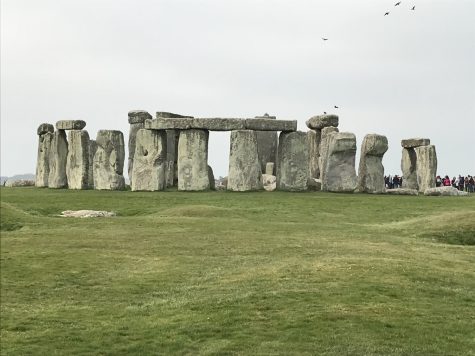 with revelers after a football (soccer) match, to get gelato.
with revelers after a football (soccer) match, to get gelato.
On the seventh day, a small posse of students, led by Mernagh and Berzy, went on their bonus trip to Stonehenge and the town of Salisbury. They got to see the mysterious stone monument built by prehistoric peoples and visit the Cathedral of Salisbury, home to a copy of the Magna Carta (England’s charter of rights) and the world’s oldest clock. Afterwards, the kids got an hour to split up, eat lunch, and shop in the town. The rest of the group toured London, visiting notable landmarks like Buckingham Palace a day early and shopping. The two groups converged for another supper of bangers and mash. Some pods opted to continue browsing stores that night, while the rest took the tube back to the hotel.
On April 1, riding a new coach driven by Malcolm and led by Stewart, an umbrella wielding tour guide, the GHS Travel Group set off on a final day of adventure, starting with Windsor Castle.
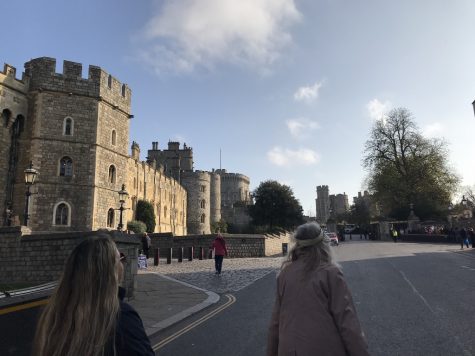
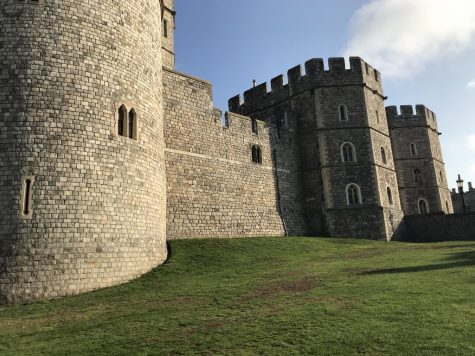
Windsor Castle is the oldest and largest inhabited castle in the world and has housed royalty for one thousand years. It is the preferred residence of Queen Elizabeth II of England and home to St. George’s Chapel, where countless monarchs and members of the royal family have worshipped, married, and are laid to rest. Different parts of the castle were built by different monarchs, so the architecture varied from a Norman tower to a Georgian palace known as the State Apartments, where the Queen resides. The Royal Standard Flag flew from the Round Tower, built by William the Conqueror, symbolizing that the Queen was currently at the castle. However, she did not make a public appearance.
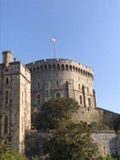
Two tours, Ceremonial and Historical, were available; the Ceremonial Tour of the State Apartments included: The Grand Reception Room; the Grand Staircase, containing several suits of armor, guns, and a statue of George VI; the Grand Vestibule, which has a display of muskets and a statue of Queen Victoria; St. George’s Hall, which houses portraits of monarchs from James I to George III and a ceiling full of different royal and noble families’ coats of arms; the Waterloo Chamber, a hall dedicated to the generals and royals who defeated Napoleon at Waterloo; and countless other treasures. The Historical Route showed people through the state apartments built for Charles II and his wife Catherine of Braganza. Visitors learned about the design of the rooms and decor and what life was like in the historic royal court. Outside the castle, there avenues of cafes, stores, and a connection to the subway.
Later, Stewart and Malcolm led everyone on a coach tour of London. They stopped for ten minutes at the Albert Memorial & Royal Albert Hall, both dedicated in memory of Queen Victoria’s husband. After that they stopped at Buckingham Palace, the queen’s other London residence and the most recognized building in England. Time was sparse, so Westminster Abbey, the gothic church of royalty, had to be a quick stop. The coach meandered through the different sections of London, while Stewart humorously explained the history behind all of it. Finally, Malcolm and Stewart dropped the group off in Trafalgar Square, the heart of the city, and said farewell. The pods had an hour to go shopping or visit the nearby National Gallery before everyone walked to dinner.
After a supper of barbecue chicken, the GHS Travel Group enjoyed one final  spectacle. They walked to the nearby West End theater to see Wicked, the beloved musical regaling the misunderstood tale of the Wicked Witch of the West from The Wizard of Oz. With amazing special effects, cherished songs like “Defying Gravity” and “Popular”, and a triple threat cast of performers who could sing, dance, and act, Wicked was a high note to end the holiday on.
spectacle. They walked to the nearby West End theater to see Wicked, the beloved musical regaling the misunderstood tale of the Wicked Witch of the West from The Wizard of Oz. With amazing special effects, cherished songs like “Defying Gravity” and “Popular”, and a triple threat cast of performers who could sing, dance, and act, Wicked was a high note to end the holiday on.
On April 2, despite being right next to Heathrow Airport, the GHS Travel Group drove to Gatwick Airport, where they said goodbye to Joe and boarded a flight to Reykjavik. After an hour in Reykjavik, they flew across the ocean back to O’Hare and took a bus back to Griffith High School, where their eager families awaited them. By now, nine days far from home had evoked feelings of homesickness and fatigue, so everyone was glad to be back in their own country and homes. Despite their jetlag, teachers and students returned to school the following day, April 3, ready for make-up work with memories of the trip of a lifetime.
“I thought it was going to be stressful, but I felt very relaxed and comfortable in a foreign country,” said Thomas. “It made me sure that I want to travel in later times.”


